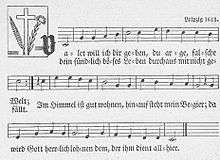Valet will ich dir geben
| "Valet will ich dir geben" | |
|---|---|
| Hymn by Melchior Teschner | |
 The Sterbelied (hymn for the dying) in a Protestant hymnal, 1901 | |
| English | I want to bid you farewell |
| Text | by Valerius Herberger |
| Language | German |
| Composed | 1613 |
| Published | 1614 in Leipzig |
"Valet will ich dir geben" ("I want to bid you farewell"[1] or I shall say farewell to thee[2]) is a Lutheran hymn, written by Valerius Herberger in 1613 with a melody by Melchior Teschner. A Sterbelied (hymn for the dying), it is part of the current German hymnal.
Text
Herberger wrote the hymn in 1613 in response to the plague in Fraustadt, [1][3] as a Sterbelied (hymn for the dying),[3] It was first printed in Leipzig in 1614.[4] The subtitle reads "Ein andächtiges Gebet, damit die evangelische Bürgerschaft zu Fraustadt Anno 1613 im Herbst Gott dem Herrn das Herz erweicht hat, daß er seine scharfe Zuchtrute, unter welcher bei zweitausend Menschen sind schlafen gegangen, in Gnaden hat niedergelegt. Sowohl ein tröstlicher Gesang, darinnen ein frommes Herz dieser Welt Valet gibt.“ (A devotional Prayer, by which in the Autumn of the Year 1613 the Reformed Citizens of Fraustadt softened the Heart of the Lord God, so that He mercifully laid down His sharp scourge, under which two thousand Men and Women had gone to sleep. Likewise a Song of Consolation, wherein a pious Heart sayeth Farewell to this World.)[5]
The first word, "Valet", is derived from the Latin valete (fare thee well). Herberger arranged his own Christian name as an acrostic: the first letters of each of the five stanzas form his name, Vale R I V S.[5]
Melody and music
Teschner, the composer of the melody, wrote two settings for five parts, published in 1615 in Ein andächtiges Gebet (a devotional prayer).[3] Johann Sebastian Bach composed two chorale preludes (BWV 735 and 736). He used the first stanza of the hymn as movement 3 in his cantata Christus, der ist mein Leben, BWV 95,[1][2] and the third stanza, "In meines Herzens Grunde" (Within my heart's foundation), in his St John Passion.[6]
Naji Hakim composed in 2011 "Valet will ich dir geben / 5 Variations for Choir and Organ on a Choral by Melchior Teschner".[7]
Several hymns are sung to the same tune, including "All Glory, Laud and Honour", and the tune is also known as "St. Theodulph" after Theodulf of Orléans who is the author of the Latin hymn which became, in John Mason Neale's English translation, "All Glory, Laud and Honour."
"Valet will ich dir geben" is part of the current German Protestant hymnal Evangelisches Gesangbuch (EG) under number 523.
References
- 1 2 3 "Valet will ich dir geben / Text and Translation of Chorale". bach-cantatas.com. 2003. Retrieved 12 April 2014.
- 1 2 Dellal, Pamela. "BWV 95 - "Christus, der ist mein Leben"". Emmanuel Music. Retrieved 12 April 2014.
- 1 2 3 "St. Theodulph (Teschner)". hymnary.org. Retrieved 12 April 2014.
- ↑ "Chorale Melodies used in Bach's Vocal Works / Valet will ich dir geben". bach-cantatas.com. 2005. Retrieved 12 April 2014.
- 1 2 Albrecht, Christoph (1995). Einführung in die Hymnologie. Göttingen. pp. 36ff.
- ↑ Ambrose, Z. Philip (2012). "BWV 245 Johannes-Passion". University of Vermont. Retrieved 29 March 2014.
- ↑ "Valet will ich dir geben". Schott. Retrieved 12 April 2014.